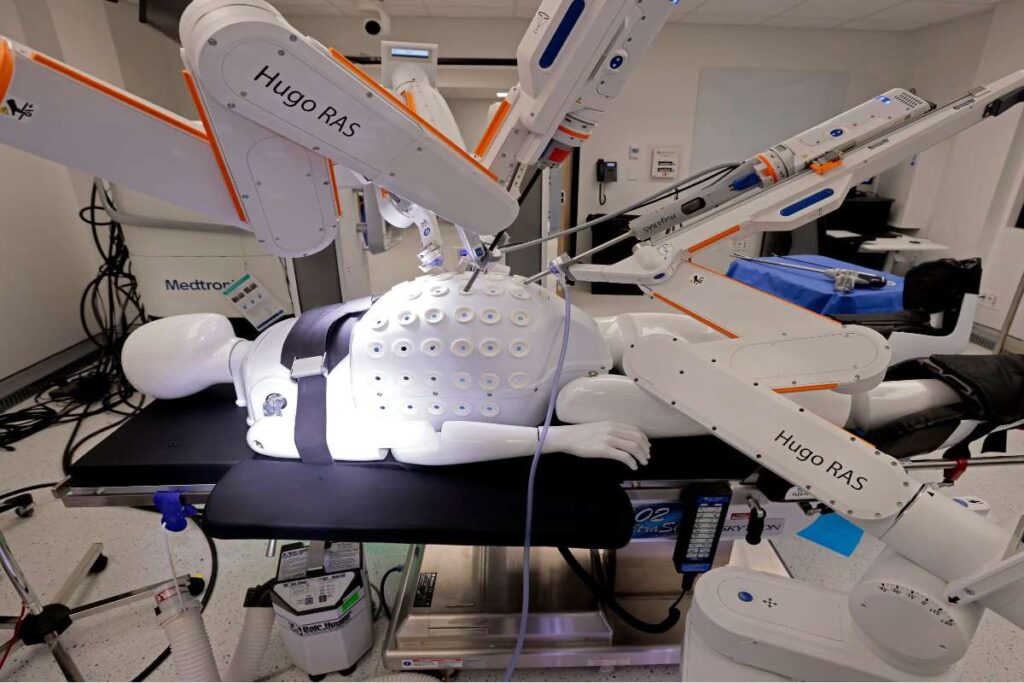In 1961, Fannie Lou Hamer, a black female civil rights activist, was scheduled for a surgical operation. Doctors had agreed to help her remove a problematic tumor in her uterus. But at the last minute, they gave her a hysterectomy — a surgical operation to remove the uterus, making it impossible for her to have a child.
Fannie Lou Hamer was furious. She was never informed about the plan to remove her uterus. She never gave her consent to such a life-altering decision. Sensing foul play, she vowed to fight for herself and other black women who could be potential victims.
Just like her, many other black women had to endure excruciating consequences over growths in their uteri. Hamer endured untold pain and discomfort. She also suffered heavy bleeding and found it difficult to conceive. The best option was to undergo surgery to have the tumor removed.

The 44-year-old African American, who was also a successful farmer, approached a hospital in Sunflower County, Mississippi. She was confident about getting quality medical attention and leaving the hospital with newfound freedom. Little did she know that the white doctor who was to conduct the surgery had a “wicked plan on his mind.”
The removal of her uterus meant that it was medically impossible for her to have a child. It was a devastating realization that she couldn’t keep to herself. In the end, what was expected to be a straightforward hospital visit soon escalated into a subject of national outrage.
A Fight for Women’s Rights Opens a Can of Worms
There are a few possible explanations for the doctor’s actions. However, Hamer refused to be convinced by any, including the possibility that he may have wrongly diagnosed her condition. She insisted that he acted based on hateful motives and, just like many other racist doctors, wanted to diminish the black race on the surgery table.
At the time, news was going around about white doctors intentionally sterilizing black women to prevent the expansion of the black race. Hamer was sure that she was the latest victim of the sinister program.
She vowed to fight this plan to the finish. No other black woman should pass through the same ordeal. Little did she know that her activism was about to expose more bone-chilling discoveries.

Delving deeper, Hamer found out that there were tens of thousands of black women who had been sterilized in similar circumstances. Since the 1920s, white doctors had been removing the uteruses of black women without their consent.
Reports show that at least 80,000 Black women underwent hysterectomies without their consent from the 1920s to the 1980s. A vast majority of these women fell victim to this racist scheme after seeking treatment for unrelated medical conditions.
Hamer later tagged these involuntary surgeries “Mississippi appendectomies.” She chose the name because the doctors told the patients that they were performing regular surgeries such as appendectomies. But why is a hysterectomy such a big deal?
What Is a Hysterectomy?
A hysterectomy is a surgical procedure for the partial or complete removal of the uterus. The uterus is a hollow, pear-shaped organ in the lower abdomen of a woman’s body. This organ houses the baby during pregnancy and is therefore a key part of the female reproductive system.
During a hysterectomy, only part of the uterus could be removed. This is called a partial hysterectomy. The total hysterectomy could involve the removal of the uterus and other organs such as the cervix, the fallopian tube, and both ovaries.

For cancer treatment, a radical hysterectomy is done where a part of the vagina and some additional tissues are removed as well. The type of hysterectomy performed depends on the severity of the medical condition, the patient’s age, and their wishes.
A hysterectomy is a life-changing procedure and a big decision for every woman. That’s because once the uterus is removed, there is no going back. The patient can no longer get pregnant. The procedure could also lead to other health complications.
Surgical hysterectomies surfaced in the mid-19th century. But it wasn’t until the early 20th century that abuses became rampant. The misogynistic and highly racist society poured fuel on the fire.
Hysterectomies and the Plan to Decimate the Black Race
A campaign to “improve” the quality of the human race surfaced in the early 1900s. It was called the eugenics movement. The objective was to diminish the population of minority and marginalized groups through selective breeding.
Some doctors keyed into the cause and targeted women of color, women living with disabilities, and poor women. Any woman belonging to any group or class that was deemed unattractive was a target.

This was the driving force of the involuntary hysterectomies tens of thousands of Black women went through. Native American women were also heavily affected.
Most of these women, ignorant about the process, were placated by lies. Some were told that the procedure was a necessary life-saving measure. Others were told that its effects would later reverse.
Hamer discovered the decades of injustice and deceit and dedicated her life to bringing an end to it. While at it, she and her husband Perry Hamer adopted two daughters and survived through the pain.
Her fight led her to become a leading voice against involuntary hysterectomies. Using her influence as a civil rights champion, she told her story to tens of thousands of people. Her testimony encouraged other victims to speak up.
In addition, Hamer was able to link the issue to other human rights issues facing the black population, especially women. Soon enough, her advocacy began to yield results. She helped spark enquiries into forced sterilizations and put doctors on their toes.
Thanks to Hamer, other black women were educated about the looming danger. In 1974, riding on the momentum from Hamer’s activism, two Black sisters, Minnie and Mary Alice Relf, filed a lawsuit challenging their forced sterilization.
The case, known as Relf v. Weinberger, further amplified the issue. As a result, reforms began to emerge. These included a ban on the sterilization of minors and the mandated use of consent forms.
Medical Milestones in Hysterectomies
Before surgical hysterectomies came on the scene, humans had found extremely crude ways to remove the uterus. There are records of ancient hysterectomies done by the Greeks and Romans.
Most of these procedures were attempted due to life-threatening bleeding after childbirth, and mostly ended in fatalities. However, in the 19th century, surgical forms gained popularity and evolved through the contributions of certain geniuses.
The First Documented Hysterectomies (1810s)
In 1812, the first recorded hysterectomy was performed by German physician Conrad Langenbeck. He successfully removed the uterus of a patient through the vagina. The patient survived.
English doctor Charles Clay tried to perform a hysterectomy in 1818 by cutting through the patient’s abdomen. Sadly, the patient lost too much blood and died in the process.
James Marion Sims Unveils the First Major Advancement (1840s and 1850s)
American physician and surgeon James Marion Sims developed an interest in hysterectomies. Also regarded as the “father of modern gynecology,” Sim’s interest yielded fruit.
He discovered the “Sims position,” a lying posture for patients that gave the best view and access to the cervix and uterus. He also invented the “Sims speculum,” a device that holds the vagina open and provides the easiest access to the uterus. The instrument is still in use to date.

He also discovered a groundbreaking surgical manipulation of the uterus that allowed for better inspection and analysis of the pelvic region. Sims also developed a technique that fast-tracked healing and reduced the risk of infection after the surgeries.
Anesthesia Comes on the Scene (1846)
All the while, hysterectomies were performed as quickly as possible to enable patients to survive the pain. But things changed after anesthesia was introduced. Anesthesia numbed the body and allowed doctors to conduct more careful and precise sterilizations.
It was Crawford Long who changed the surgical world with his discovery of ether anesthesia in 1846. The introduction of anesthesia ultimately made the surgeries less fatal.
Improved Infection Control (1860s to 1870s)
The future of hysterectomies became even brighter in the 1860s and 1870s. Joseph Lister began sterilizing instruments and wounds with carbolic acid.
This reduced infections and lowered deaths from about 70% to about 25%. This breakthrough made a significant contribution to increasing the popularity of hysterectomies.
Radical and Subtotal Hysterectomies, Blood Transfusions, and Antibiotics (1890s – 1930s)
Ernst Wertheim introduced radical hysterectomy for patients with cervical cancer. This technique reduced the fatality rate.
Then came blood transfusions and antibiotics. While the breakthrough in safe blood transfusion helped address the challenge of blood loss, antibiotics further reduced the likelihood of infection.
During this period, surgeons discovered the subtotal hysterectomy, where the cervix is left behind and only the upper uterus is removed. This style has been shown to reduce mortality rates for conditions involving fibroids.
The Technological Evolution: Laparoscopy and Robotic-Assisted Hysterectomy (1950s to 2000)
From 1950 to 2000, hysterectomy experienced massive development. It began with the laparoscopy, where small cameras are introduced into the patient’s body through small incisions. This made the procedure faster and less messy.

By the 1990s, technology began to play an even bigger role. Robotic-Assisted Hysterectomy became a thing. Surgeons began to direct the arms of robots, thereby achieving higher precision and minimal harm.
Hysterectomies and the Fight for Women’s Rights
Although Fannie Lou Hamer elevated the fight for women’s reproductive rights to an unprecedented level, the struggle had begun long before she came on the scene. Women never stayed silent in the face of oppression. Let’s see where it all began.
The Rise of the Feminist Movement (1848)
In 1848, the feminist movement introduced the first organized women’s rights movement. At the forefront of this struggle was the supremely courageous Elizabeth Cady Stanton.

However, the movement started with advocating for voting rights. The closest it came to reproductive rights was its advocacy for body autonomy. At the time, women’s bodies were regarded as property of men and the government. But with sustained pressure from the movement, that stance began to give in.
Feminism Reloaded (the 1960s)
The 1960s witnessed the emergence of a more radical wave of the feminist movement. A more exposed set of women fueled this one.
Leading the campaign were activists such as Margaret Sanger and Mary Ware Dennett. This time, their torchlight shone more on reproductive health and its issues, such as forced hysterectomies.
These women clamored for more control over reproductive decisions. Thankfully, their fights produced remarkable victories. One such case was the Griswold v. Connecticut (1965) Supreme Court decision.
In this case, the court ruled that women had the right to make reproductive choices. This included the use of contraceptives for married couples and the right to decide on hysterectomies. Sanger would later found Planned Parenthood.
Another achievement for the movement was the iconic Roe v. Wade, which cleared the way for women to have the final say on abortion. The 1973 Supreme Court ruling also consolidated the court’s stance on the right to decide on hysterectomies.

Increased Push for Hysterectomy Awareness and Alternatives (1980s)
At the turn of the 1980s, hysterectomy had become highly popular. Aside from cesarean sections, it was the most common surgery for women in the United States. This surge necessitated more education about hysterectomies and safer alternatives.
Nora W. Coffey took on this crucial responsibility. Through her NGO, the Hysterectomy Educational Resources and Services (HERS) Foundation, she bridged the knowledge gap for many women.
Founded in 1982, the organization educated women about less invasive alternatives, such as the use of medication. Coffey had herself undergone an unnecessary hysterectomy; she wanted to ensure that no other woman made the same mistake.
Coffey provided learning resources, counseling services, and other forms of support to women who were unfamiliar with the procedure. The knowledge she imparted proved helpful in helping women make informed decisions.
Modern Hysterectomy and the Future
The practice of hysterectomy has undergone significant evolution since the 19th century. Not only has it undergone medical evolution to become safer and easier, but it has also experienced a shift in ethics and legality, all thanks to the men and women who gave themselves for the cause.

Now women don’t have to fear being forcibly sterilized or dying on a surgical table. Currently, the death rate for hysterectomy in the United States, the United Kingdom, and a majority of countries across the world is less than 1%.
The introduction of more advanced technologies, such as MRI and 3D ultrasound, has helped women avoid unnecessary hysterectomies through more accurate diagnosis. Women who cannot avoid it aren’t forced to get it. For women across the world, we can boldly say that the bondage of the past is over.


